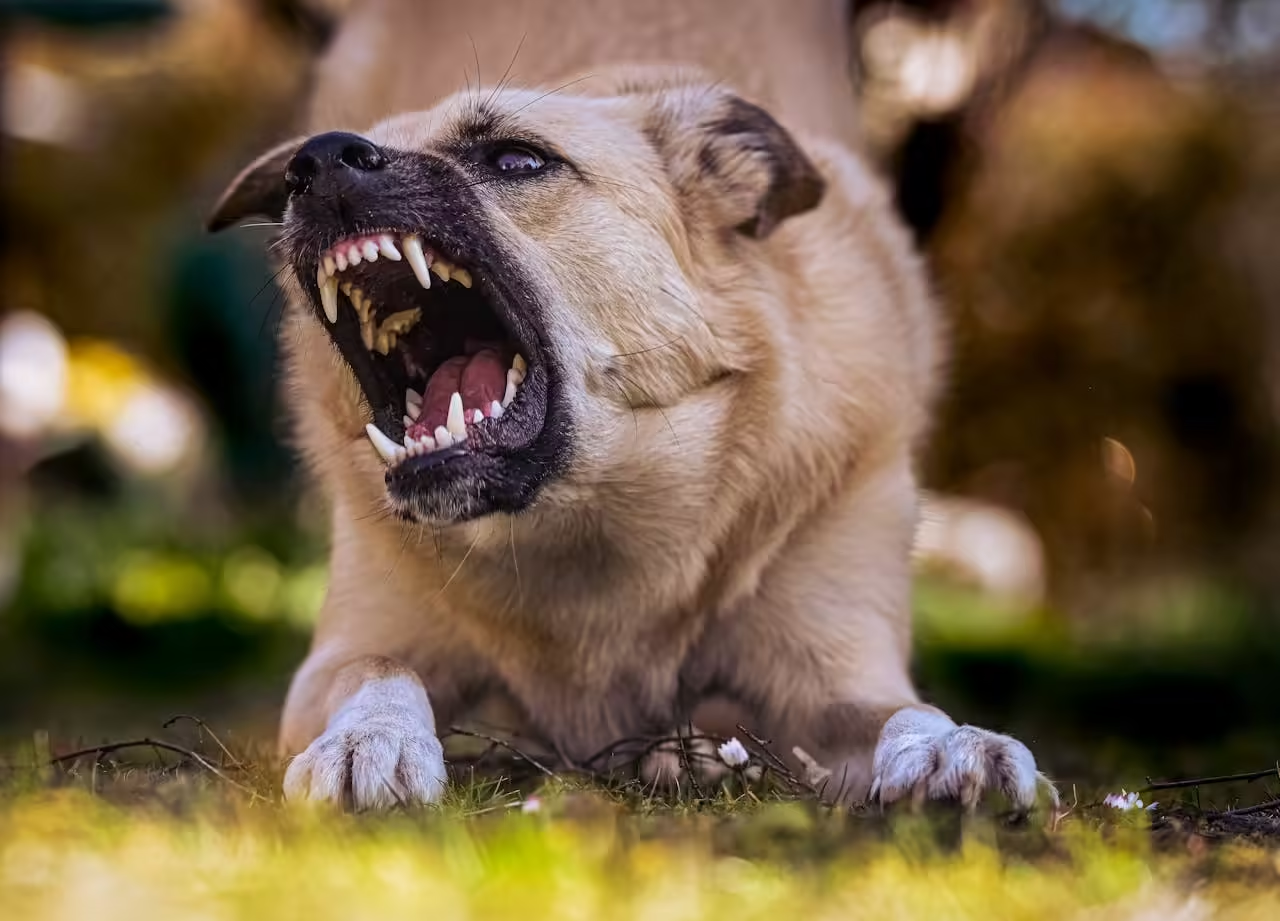
The history of guard dogs is as ancient as civilization itself, with their presence dating back to times when they protected livestock and properties from predators and intruders. The Romans, for instance, used dogs to guard their homes, often signaling the presence of these fierce protectors with ‘Cave Canem’ mosaics at the entrance of their houses. Over time, the role of guard dogs has evolved, with breeds like the Mastiff and the Great Dane being recognized for their guarding instincts. Photo by Alexas Fotos
Read these first:
- Outbreak Alert 2020: Wuhan Virus Spreads from Human to Human
- Health 101: Celebrating World Rabies Day
- Agriculture 101: Navigating the Challenges of Tenacious Pig Farming
- Taiping Trips 101: Black Panther! Courting Danger with One in Taiping!
- Nuisance 101: Damn, I Hate Cats! They Are So Evil!
Introduction
Guard dogs have been integral to human society for centuries, serving various essential roles that extend beyond mere companionship. Historically, these canines have been employed to protect properties, livestock, and even human lives. Their keen senses, loyalty, and innate protective instincts make them invaluable assets in maintaining security and safety.
The primary roles of guard dogs encompass protection, deterrence, and companionship. Protection is perhaps the most evident function, as these dogs are trained to defend their owners and their property from potential threats. They are often used in residential, commercial, and rural settings to provide a robust line of defense against intruders or predators. Their mere presence can act as a powerful deterrent, discouraging trespassers and criminals from attempting unlawful activities.
In addition to their protective capabilities, guard dogs also offer companionship. Despite their formidable appearance and skills, many of these breeds are inherently loyal and affectionate towards their families. This dual role enhances their value, providing both security and emotional support to their owners.
Choosing the right guard dog breed is crucial, as each breed has distinct characteristics and abilities suited to specific needs and environments. Factors such as temperamental attributes, size, strength, and trainability must be considered to ensure the dog can effectively fulfill its intended role. For instance, a large, imposing breed may be suitable for guarding expansive properties, while a smaller yet alert breed might be better suited for more confined spaces.
Please accept YouTube cookies to play this video. By accepting you will be accessing content from YouTube, a service provided by an external third party.
If you accept this notice, your choice will be saved and the page will refresh.
.
Guard dogs have been instrumental in ensuring safety and security across various settings. Their vigilant nature and protective instincts make them ideal for confronting potential threats such as intruders, kidnappers, and robbers. These loyal canines are not only trained to alert their handlers of suspicious activity but also to act bravely in the face of danger, often putting themselves at risk to protect their charges. Their presence alone can be a powerful deterrent, and their actions in critical situations have time and again proven invaluable in crisis management and resolution.
Effective Guard Dogs
Effective guard dogs possess a unique combination of traits that enable them to excel in protective roles. These characteristics not only ensure the safety and security of their human companions but also enhance the overall functionality and reliability of the breed in guard duties.
Loyalty is a fundamental trait for any guard dog. A loyal dog forms a strong bond with its owner, which translates into a heightened sense of duty and protectiveness. This unwavering loyalty ensures that the dog will always prioritize the safety of its family, making it a reliable guardian.
Strength is another critical attribute. Guard dogs need to have the physical power to deter and, if necessary, subdue potential threats. Breeds with robust and muscular builds are better equipped to handle physical confrontations, providing an additional layer of security.
Intelligence is equally vital. Intelligent dogs can quickly assess situations, determining friend from foe with greater accuracy. This cognitive ability allows them to respond appropriately to various scenarios, ensuring that they act as effective protectors without unnecessary aggression.
Trainability is closely linked to intelligence. A trainable dog can be taught specific commands and behaviors, making them more versatile and adaptable in their guarding role. This trait is essential for obedience, ensuring that the dog follows instructions promptly in critical situations.
Territorial instincts play a significant role in a guard dog’s effectiveness. Dogs with strong territorial instincts naturally perceive their home and family as their domain, which they are driven to protect. This intrinsic motivation makes them vigilant and proactive in guarding their environment.
Alertness is the final key characteristic. An alert guard dog is always aware of its surroundings, ready to react to any unusual activity. This heightened state of awareness enables early detection of potential threats, providing a crucial advantage in preventive security measures.
Together, these traits form the foundation of an effective guard dog. The synergy of loyalty, strength, intelligence, trainability, territorial instincts, and alertness ensures that these breeds are well-equipped to provide reliable protection and peace of mind to their owners.
Top Guard Dog Breeds
When it comes to selecting the best guard dog breeds, certain names consistently emerge at the top of the list due to their exceptional abilities and characteristics. These breeds are renowned for their loyalty, intelligence, and protective instincts, making them ideal choices for security and companionship. Let’s explore some of the most recognized and effective guard dog breeds.
Each of these breeds brings unique qualities to the table, making them some of the best options for those seeking a reliable and effective guard dog. Their histories, behaviors, and abilities collectively showcase why they are considered top choices for protection and companionship.
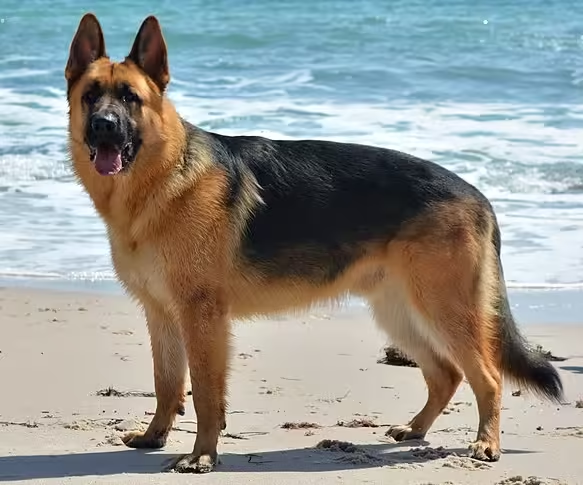
The German Shepherd is a breed with a storied past that began in Germany at the close of the 19th century. Developed by Max von Stephanitz, a former cavalry captain and veterinary student, the breed was standardized using various local German herding dogs. These dogs were valued for their intelligence, strength, and versatility, and were initially bred for herding sheep. Over time, they have been employed in a wide range of roles, including police work, search-and-rescue, and as service animals. Image source: Wikipedia/Gomagoti
German Shepherd: The All-Rounder
The German Shepherd is often heralded as one of the most versatile and dependable guard dog breeds. Originating in Germany in the late 19th century, this breed was initially developed for herding and protecting sheep. However, its extraordinary traits quickly propelled it into a variety of other roles. The German Shepherd’s history is rich with instances of bravery and service, making it a breed synonymous with loyalty and reliability.
Physically, German Shepherds are medium to large-sized dogs, with males typically weighing between 65 to 90 pounds and females slightly lighter. They have a robust and muscular build, characterized by a strong, agile frame that allows for swift and powerful movements. Their double coat, which can be either short or long, provides excellent protection against harsh weather conditions. The breed’s most distinguishing features are their erect ears and intelligent, alert eyes that convey their readiness for action.
One of the primary reasons German Shepherds are highly regarded as guard dogs is their exceptional intelligence. Ranked among the top three most intelligent dog breeds, they are quick learners and highly trainable. This cognitive sharpness, paired with their inherent loyalty, makes them excellent candidates for various demanding roles. German Shepherds excel in police and military work, often involved in tasks such as tracking, detection, and apprehension. Their keen sense of smell and ability to follow complex commands make them invaluable in search and rescue missions, where they can locate missing persons in diverse terrains.
In addition to their professional applications, German Shepherds are also popular as personal protection dogs. Their natural protective instincts, combined with their calm demeanor and social nature, allow them to be both a family companion and a guardian. They are known to form strong bonds with their owners, making them vigilant and responsive protectors of their homes and loved ones.
In essence, the German Shepherd’s blend of physical prowess, intelligence, and versatility makes it a quintessential guard dog breed. Whether serving in high-stakes environments or providing security at home, this all-rounder breed continues to prove why it is a top choice for those seeking a reliable and capable guard dog.
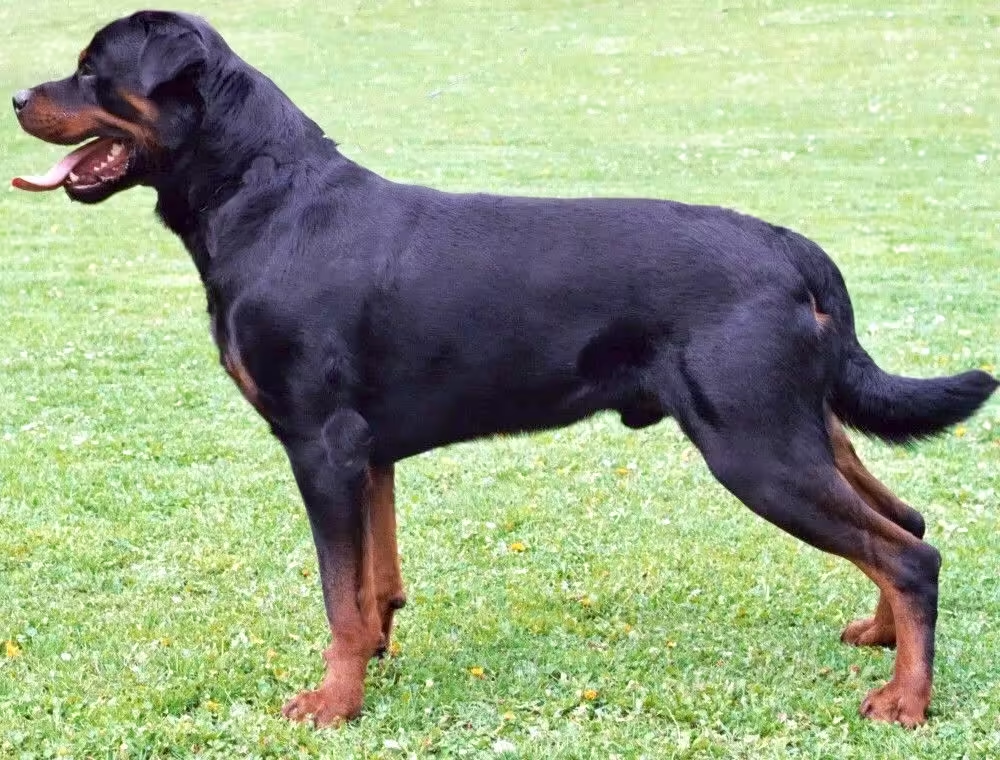
The Rottweiler, a breed known for its strength and guarding abilities, has a history that dates back to the Roman Empire. Originally used as herding dogs, they were integral in moving and protecting livestock as the Romans expanded their territory. The breed’s name is derived from the German town of Rottweil, where they were known as “Rottweiler Metzgerhund,” indicating their role in herding and guarding butchers’ livestock. Image source: Wikipedia / Dr. Manfred Herrmann Allgemeiner Deutscher Rottweiler-Klub
Rottweiler: The Powerful Protector
The Rottweiler, known for its strength and loyalty, has a storied history that dates back to the Roman Empire. Originally utilized as herding dogs and protectors of livestock, Rottweilers have evolved into one of the premier guard dog breeds due to their inherent guarding instincts and powerful build.
Physically, Rottweilers are robust and muscular, with a broad chest and a strong jaw. Their coat is short, dense, and typically black with distinctive tan markings. Males typically weigh between 95 to 135 pounds, while females range from 80 to 100 pounds. Despite their imposing appearance, Rottweilers are known for their calm and confident demeanor, making them both formidable protectors and loving family pets.
The strength and courage of the Rottweiler are unparalleled. Their natural guarding instincts make them highly alert and protective of their territory and loved ones. This breed is exceptionally loyal and will go to great lengths to ensure the safety of their family. Rottweilers are also highly intelligent and have a strong work ethic, which makes them ideal candidates for roles in police work, search and rescue, and service dog duties.
However, owning a Rottweiler comes with specific responsibilities. Due to their strength and assertiveness, proper training and socialization from an early age are crucial. It is recommended to start obedience training during puppyhood to instill good behavior and prevent potential issues. Positive reinforcement techniques work best, as Rottweilers respond well to rewards and praise. Consistent training will help in raising a well-balanced and well-mannered dog.
In addition to training, Rottweilers require regular exercise to maintain their physical and mental health. Daily walks, playtime, and engaging activities are essential to keep them stimulated and prevent boredom-related behaviors. A well-exercised Rottweiler is a happy and content companion.
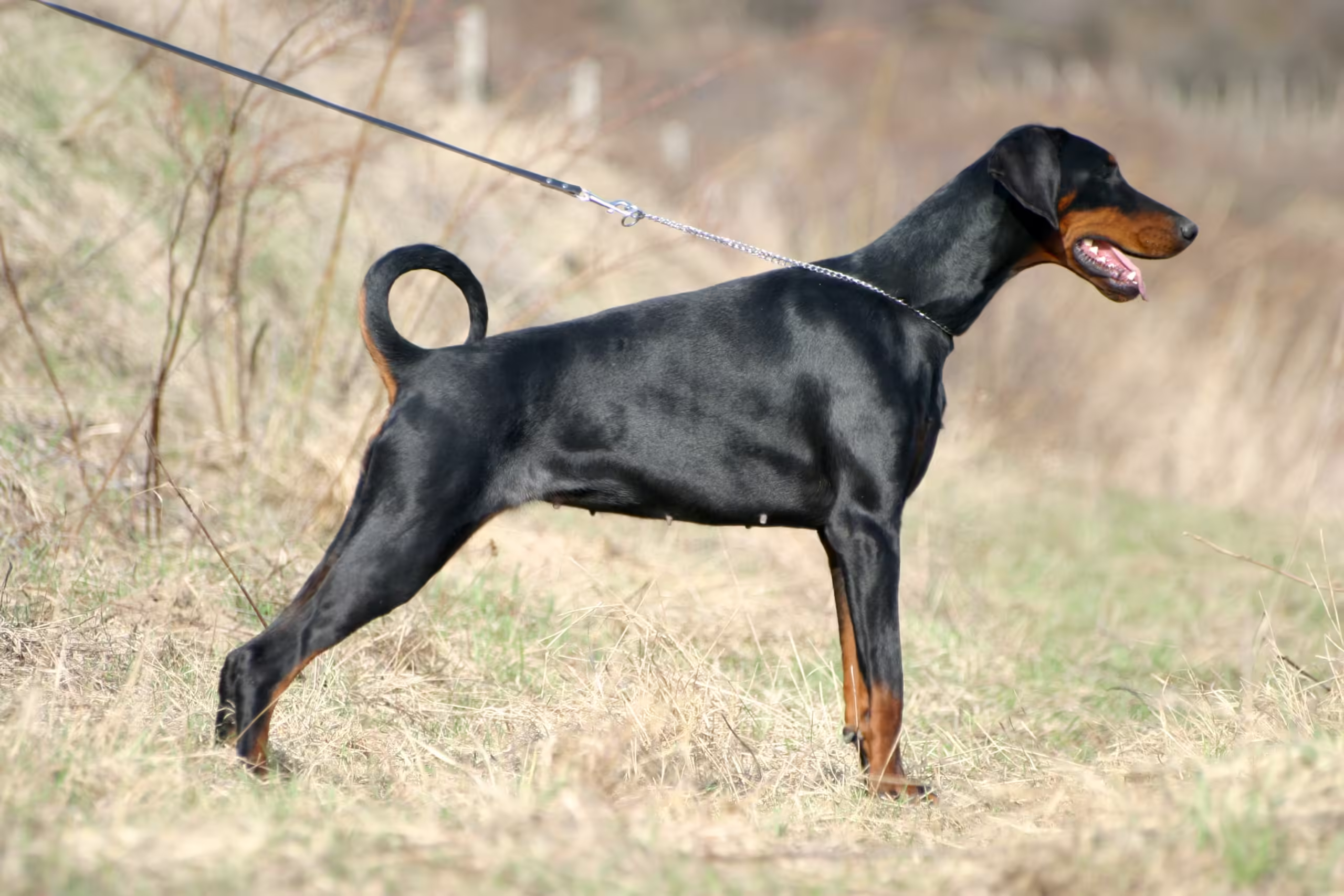
The Doberman Pinscher, a breed with a storied past, originated in the late 19th century in Germany. Created by Karl Friedrich Louis Dobermann, a tax collector, the breed was designed to be intimidating yet intelligent, aiding him in his dangerous line of work. The Doberman’s ancestry is believed to include a mix of breeds such as the Rottweiler, German Pinscher, and Weimaraner, contributing to its strength, intelligence, and versatility. Image source: Wikipedia / Miroslav Cacik
Doberman Pinscher: The Elegant Guardian
The Doberman Pinscher is renowned for its sleek and elegant appearance, which belies a robust and powerful physique. This breed’s agility and speed make it an exceptional choice for a guard dog, capable of responding swiftly to any threat. Notably, the Doberman’s keen sense of loyalty is one of its most defining traits, which makes it not only a vigilant protector but also a devoted family companion.
Intelligence is a hallmark of the Doberman Pinscher, and their capacity for learning commands and tasks is impressive. This high level of intelligence facilitates ease of training, allowing them to excel in obedience and protection roles. Their ability to quickly pick up on training makes them suitable for families seeking a reliable and well-mannered guard dog. Additionally, Dobermans are known for their alertness, always staying aware of their surroundings, which further enhances their role as protectors.
However, there are specific considerations to keep in mind when it comes to the care and training of a Doberman Pinscher. Regular physical activity is essential to maintain their health and well-being, as this breed is highly energetic and requires ample exercise. Mental stimulation is equally important to prevent boredom, which can lead to destructive behaviors. Engaging them in activities such as agility training, obedience courses, and interactive play can help meet these needs.
Socialization from a young age is crucial for Dobermans, ensuring they develop into well-rounded adults. Exposure to different environments, people, and other animals can help mitigate any potential aggression and foster a balanced temperament. Consistent training, combined with positive reinforcement techniques, will yield the best results, promoting a strong bond between the Doberman and its family.
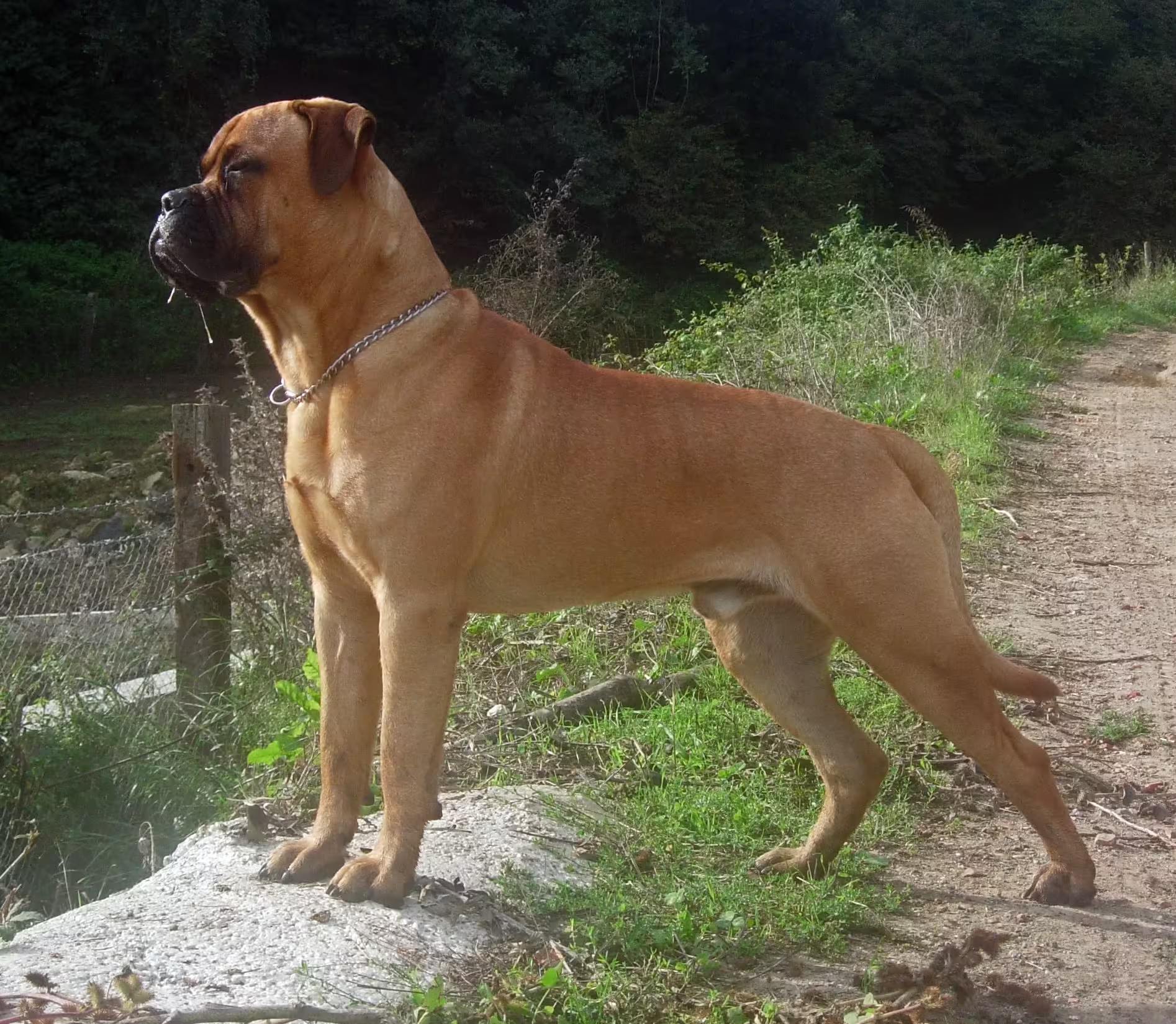
The Bullmastiff is a powerful dog breed with a rich history dating back to the 19th century in England. Originally bred by crossing the Old English Bulldog and the English Mastiff, the Bullmastiff was developed to assist gamekeepers in protecting estates from poachers. Recognized by the American Kennel Club in 1933, the Bullmastiff is now a cherished family companion, known for its calm and dependable disposition when properly trained and socialized. Image source: Wikipedia / Fausto Moreno
Bullmastiff: The Gentle Giant
The Bullmastiff is a breed known for its impressive size and gentle disposition. Originating in the 19th century, this breed was developed in England to guard estates against poachers. The Bullmastiff’s role as an estate guardian required a combination of strength, courage, and intelligence, traits that are still evident in the breed today. This unique blend of characteristics makes the Bullmastiff a formidable guard dog while also being a gentle and affectionate family companion.
Standing between 24 to 27 inches tall at the shoulder and weighing between 100 to 130 pounds, the Bullmastiff is indeed a giant among dogs. Despite their imposing stature, they are known for their calm and docile nature. These dogs are generally quiet and reserved, barking only when necessary, which is a testament to their confident and composed demeanor. Their calm behavior makes them well-suited for family life, including households with children. Bullmastiffs are known to be exceptionally patient and protective of young ones, often forming strong bonds with family members.
One of the most notable features of the Bullmastiff is its protective instinct. These dogs are naturally wary of strangers and will not hesitate to defend their home and loved ones if they perceive a threat. However, their protective nature is balanced by their keen sense of discernment, allowing them to differentiate between a real threat and a benign situation. This makes them reliable guardians who do not overreact or become unnecessarily aggressive.
In terms of exercise needs, Bullmastiffs are relatively low-maintenance. They do not require extensive physical activity, making them suitable for families with varying lifestyles. A daily walk and some playtime are usually sufficient to keep a Bullmastiff healthy and content. Their low exercise requirements, combined with their gentle nature and protective instincts, make them an ideal choice for those seeking a dedicated and family-friendly guard dog.
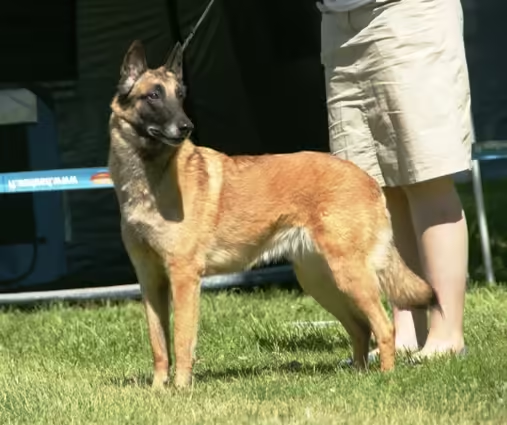
The Belgian Malinois, a breed known for its intelligence and work ethic, originated in the late 19th century in the city of Mechelen, Belgium. Developed by local farmers, the Malinois is one of four varieties of Belgian herding dogs, distinguished by its short fawn or mahogany coat. Initially bred for herding and guarding livestock, the breed has evolved into a versatile working dog, serving in roles such as police and military K-9s due to their exceptional strength, stamina, and loyalty. Image source: Wikipedia / Canarian
Belgian Malinois: The Agile Defender
The Belgian Malinois is renowned for its agility and exceptional working abilities, making it a top choice for roles in military and police forces worldwide. This breed is characterized by its high energy levels and remarkable intelligence, which contribute to its effectiveness in demanding environments. The Belgian Malinois is often employed in various capacities, including search and rescue missions, detection of explosives and narcotics, and as a reliable partner in apprehension tasks.
Physically, the Belgian Malinois is a medium-sized dog, typically weighing between 60 to 80 pounds and standing 22 to 26 inches tall at the shoulder. Their lean, muscular build and short coat, which comes in shades of fawn, mahogany, and black, allow for both speed and endurance. These physical attributes, combined with their keen senses and alertness, make them well-suited for strenuous and high-stakes activities.
The intelligence of the Belgian Malinois is one of its most defining traits. This breed thrives on mental stimulation and is quick to learn new commands and tasks. Training a Belgian Malinois requires consistency and patience, but the reward is a highly skilled and dependable working dog. Their aptitude for learning, coupled with their unwavering loyalty, makes them not only excellent working dogs but also devoted companions.
Regular mental and physical stimulation is crucial for the Belgian Malinois to prevent boredom and destructive behavior. Activities such as agility training, obedience exercises, and interactive play are essential to keep this breed engaged and happy. Owners of Belgian Malinois must be prepared to invest significant time and effort into their dog’s training and exercise regimen.
Protective instincts are deeply ingrained in the Belgian Malinois, making them natural guardians. They are known for their strong territorial drive and will often go to great lengths to protect their family and home. This protective nature, combined with their intelligence and physical prowess, solidifies the Belgian Malinois as one of the best guard dog breeds available.
Final Say
Guard dogs have been esteemed throughout history for their vigilance and loyalty in protecting property and individuals. These canines are not merely pets; they are trained professionals who play a crucial role in security systems. The breeds often selected for such tasks include German Shepherds, Rottweilers, and Doberman Pinschers, known for their intelligence, strength, and obedience. The training of guard dogs is a meticulous process, focusing on obedience, patrol, defense, and attack training, tailored to the needs of the security task at hand.
The legal aspects surrounding guard dogs are equally important. Owners must be aware of the local regulations regarding signage and liability. In many jurisdictions, it is mandatory to post clear signs indicating the presence of a guard dog. These signs serve a dual purpose: they warn potential intruders and protect the dog owner from legal repercussions in the event of an incident.
Furthermore, the distinction between guard dogs and attack dogs is significant. While guard dogs are trained to alert their owners and deter intruders, attack dogs are trained to apprehend or neutralize a threat and are often employed by law enforcement or military services. The level of force used by these dogs is carefully regulated and is a subject of continuous ethical debate.
In the context of liability, the presence of warning signs may not absolve the owner of responsibility if the guard dog causes harm. It is generally advised to maintain proper signage not only as a deterrent but also as a legal safeguard. The absence of such signs could potentially lead to legal complications and put the dog’s life at risk if it were to attack an individual.
Owners must also consider the welfare of their guard dogs, ensuring they are well-cared for, receive regular veterinary attention, and live in a suitable environment that caters to their physical and psychological needs. A well-maintained guard dog is more effective and less likely to exhibit unpredictable behavior.
In conclusion, guard dogs are a valuable security asset, but they come with a set of responsibilities that the owner must diligently fulfill. From training and care to legal compliance and ethical considerations, each aspect contributes to the effective and responsible use of guard dogs in safeguarding people and property.
Pingback: Nature 101: Roaring Tigers - Shrinking Population, Urgent Conservation